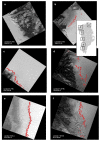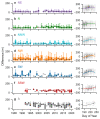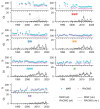Increasing surface runoff from Greenland's firn areas
- PMID: 35811787
- PMCID: PMC7613031
- DOI: 10.1038/s41558-022-01371-z
Increasing surface runoff from Greenland's firn areas
Abstract
At high elevations of ice sheets, melting snow generally percolates and refreezes, so does not contribute to the shrinking of the ice sheet. Here, we systematically map the runoff area of the Greenland ice sheet, using surface rivers visible on satellite imagery. Between 1985 and 2020, the maximum runoff elevation rose by 58-329 metres, expanding the runoff area by 29% (-8%/+6%). Excess melt beyond the refreezing capacity of pores in snowfall has created near-impermeable ice slabs that sustain surface runoff even in cooler summers. We show that two surface mass balance models over-estimate the runoff area by 16-30%. Once restricted to our observed areas they indicate that 5-10% of recent runoff likely comes from the expanded runoff area. Runoff from higher elevations is sensitive to projected warming as further increases in the runoff limit will increase the runoff area disproportionately.
Conflict of interest statement
Competing Interests Statement The authors declare that they have no competing interests
Figures


- a
LT05_L1TP_020001_1995071_20180221_01_T1 (no retrievals).
- b
LT05_L1TP_035003_19950705_20180221_01_T1.
- c
LT05_L1GS_021006_19970809_20180221_01_T2.
- d
LE07_L1TP_011010_20090812_20161218_01_T1.
- e
LC08_L1TP_006013_20190813_20190820_01_T1.
- f
LE07_L1TP_005015_20110808_20161207_01_T1.










References
-
- Enderlin EM, Howat IM, Jeong S, Noh M-J, van Angelen JH, van den Broeke MR. An improved mass budget for the Greenland ice sheet. Geophysical Research Letters. 2014;41(3):866–872.
-
- The IMBIE Team. Mass balance of the Greenland Ice Sheet from 1992 to 2018. Nature. 2019;579(7798):233–239. - PubMed
-
- Box JE, Fettweis X, Stroeve JC, Tedesco M, Hall DK, Steffen K. Greenland ice sheet albedo feedback: thermodynamics and atmosphericdrivers. The Cryosphere. 2012;6(4):821–839.
-
- Fausto RS the PROMICE team. The Greenland ice sheet - snowline elevations at the end of the melt seasons from 2000 to 2017. Geological Survey of Denmark and Greenland Bulletin. 2018;41:71–74.
Grants and funding
LinkOut - more resources
Full Text Sources
